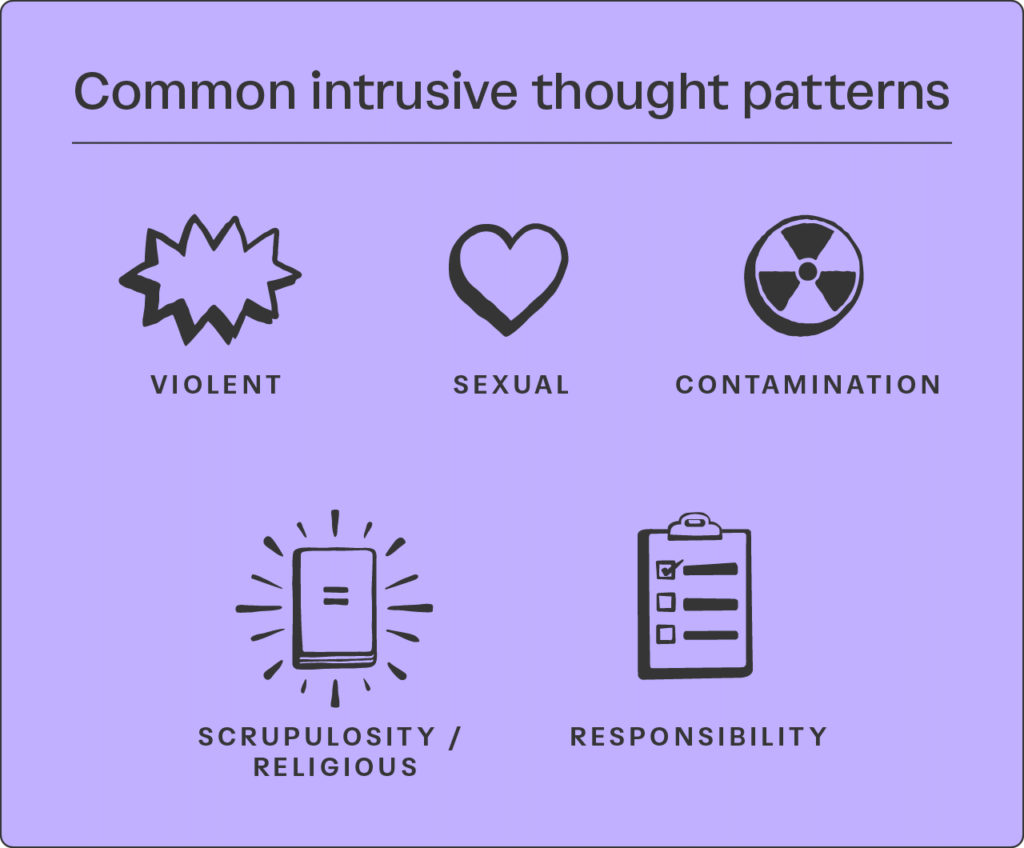Imagine a scenario where you’re in the kitchen chopping vegetables and you suddenly have the thought to cut yourself with the knife.
The thought came out of left field and you might start to get anxious or wonder why you had the thought.
This is an example of an unwanted intrusive thought. Even though they’re scary, they’re common. One study found that 94% of people surveyed experience intrusive thoughts, impulses, or mental images.
However, not all of these people experience intrusive thoughts in a way that causes them distress or in a way that impacts their day-to-day feelings and functioning.
Here’s everything you need to know about what intrusive thoughts are, what mental health conditions they’re linked to, and hope to cope with them.
What are Intrusive Thoughts?
Intrusive thoughts are unwanted, disturbing thoughts or mental images. These thoughts can be distressing, strange, scary, and totally out of character. They can come out of nowhere or pop up in response to a trigger.
“Intrusive thoughts are like that uninvited party guest who just won’t leave your head – unwelcome thoughts, images, and ideas that crash the mental party without an invite,” says Leslie E. Wilborne, a licensed professional counselor with Grow Therapy. “The surprise attack of these thoughts can really throw a mental curveball to those dealing with them.”
Types of Intrusive Thoughts and Mental Images

Intrusive thoughts and mental images can be about anything. However, there are several common themes and examples of intrusive thoughts that many people tend to experience, including:
- Violent intrusive thoughts: Thoughts about harming other people or yourself. Examples: Cutting yourself, stabbing someone, or hitting someone with your car.
- Sexual intrusive thoughts: Thoughts about sex or sex acts with someone, usually someone unacceptable or taboo. Examples: Having sex with a family member, performing sex acts with an animal, or unwanted sexual thoughts of any other taboo nature.
- Contamination intrusive thoughts: Thoughts about yourself or others getting exposed to germs, chemicals, or other contaminants. Examples: Catching a fatal sickness from someone, giving a terrible sickness to someone, your home being filled with asbestos or mold.
- Scrupulosity/religious intrusive thoughts: Thoughts or mental images about offending a higher power, blaspheming, or being immoral. Examples: Thinking you sinned, doubting your faith or fearing that you’re possessed.
- Responsibility intrusive thoughts: Thoughts about being responsible for something horrible happening or not being as careful as you should be. Examples: Fear of leaving the door unlocked, wondering if you turned off the stove or fearing you forgot to set the security alarm and a burglar might enter your home.
Misconceptions and Stigmas Surrounding Intrusive Thoughts
There’s a misconception about intrusive thoughts being your actual deep desires – but this is not true.
“It’s just a thought or an image that pops up. It does not dictate who you are as a person, and it has no impact on your morality or the actions that you’ll take,” says Amelia Pauley, a psychiatric mental health nurse practitioner with Grow Therapy.
Additionally, intrusive thoughts are typically a stark contrast to an individual’s usual thought patterns, Wilborne says. Intrusive thoughts often attack things that mean a lot to you or are opposite to your values, which is what makes them so upsetting.
Plus, because of the sometimes taboo nature of intrusive thoughts, there’s a stigma surrounding speaking up about them, Wilborne says. This makes it less likely for people to seek help, and they end up suffering alone.
Mental Health Conditions Linked to Intrusive Thoughts
Intrusive thoughts in and of themself don’t constitute a mental health diagnosis. Most experience these unwanted thoughts and don’t have a diagnosis. However, some individuals who experience intrusive thoughts do have a mental health condition. Some examples of related disorders are:
Obsessive-Compulsive Disorder
Obsessive compulsive disorder (OCD) is the mental health condition that’s most closely linked to intrusive thoughts, characterized by obsessive thoughts and compulsive behaviors. It’s important to note that while all obsessions are intrusive thoughts, not all intrusive thoughts qualify as obsessions. Obsessions bring on intense anxiety, and people sometimes feel the need to carry out compulsions to relieve the anxiety. This is known as avoidance or avoidant coping. Compulsions can be physical, such as repetitive behaviors like hand washing or checking, or mental, such as counting or reassurance-seeking.
Pauley says obsessions are often the starting point of the OCD cycle, and people engage in compulsions or rituals to try to alleviate the distress from the thoughts.
Generalized Anxiety Disorder
People with generalized anxiety disorder (GAD) have persistent worries that are hard to shake off, Wilborne says. A person with GAD might experience anxiety and distress or engage in worry, which is the GAD equivalent of a compulsion. This is a repetitive mental act that people engage in (unintentionally) to reduce anxiety that feels like problem-solving and provides the illusion of control, but doesn’t result in a concrete action step.
Panic Disorder
People with panic disorder may fixate on distorted thoughts which keeps them in a paralyzing state of fear that contributes to panic attacks, says Wilborne. Intrusive thoughts often center around having another panic attack, dying or something else terrible happening.
Social Anxiety Disorder
Social anxiety disorder can keep people trapped in a cycle of anticipating worst-case scenarios, says Wilborne. People with social anxiety might have intrusive thoughts about saying or doing something embarrassing in a social setting or being judged or rejected by others.
Post-Traumatic Stress Disorder
Post-traumatic stress disorder (PTSD)-related intrusive thoughts typically manifest a bit differently than anxiety-related intrusive thoughts. Research shows that trauma survivors with PTSD have intrusive thoughts in the form of unwanted, intrusive memories about their trauma. PTSD intrusive thoughts might also intrude in the form of flashbacks.
Comorbidity and other mental health conditions related to intrusive thoughts
Comorbidity means more than one mental health disorder is present. Many people who have an anxiety disorder, OCD, or PTSD also have at least one other co-occurring condition. Some examples are:
What Causes Intrusive Thoughts?
There is not one single concrete cause of intrusive thoughts. To understand what causes intrusive thoughts, it’s important to understand what causes mental health conditions in the first place.
Researchers still don’t know exactly what causes specific conditions, but here are some contributing risk factors:
- Genetics
- Learned behavior
- Brain differences
- Stressful or traumatic life events
There are also some lifestyle factors that could play a role in triggering or worsening everyday intrusive thoughts. These include:
- Lack of sleep
- Stress
- Hormones
Therapeutic Approaches for Managing Intrusive Thoughts
If you struggle with unwanted intrusive thoughts, especially if they’re related to a mental health condition like an anxiety disorder or PTSD, psychotherapy (talk therapy) can make a huge improvement in your quality of life.
Here are some therapy modalities that can help you:
Cognitive Behavioral Therapy
Cognitive behavioral therapy (CBT) helps you address unhealthy, unhelpful thought patterns and behaviors that are negatively affecting your mental health. A CBT therapist will help you identify your negative thought patterns and then reframe them to create healthier ones. You’ll also learn coping skills and relaxation techniques. By lowering your overall stress levels through coping skills and relaxation techniques, you might find that your intrusive thoughts start to subside. Note that traditional cognitive therapy can be counterproductive to those suffering from OCD so it’s important to speak to your therapist about the treatment that’s best for you.
Exposure and Response Prevention
Exposure and response prevention (ERP) is a sub-type of CBT that’s considered a gold-standard first-line treatment for OCD. You will face your intrusive thoughts and obsessions head-on and purposely expose yourself to triggers that feed into your obsessions and intrusive thoughts to create discomfort. This is known as exposure. It’s key to note that this exposure is gradual and progressive, going at a pace that a client can handle, with tasks defined in collaboration with a therapist.
ERP has been proven to help individuals:
- Accept and tolerate the presence of obsessive thoughts without engaging in compulsive behaviors’.
- Learn that the anxiety or discomfort decreases over time without the need for compulsions.
- Better tolerate uncertainty and the distress that comes with it (particularly important in OCD, where the drive for certainty can lead to an increase in compulsive behavior).
- Learn that feared outcomes don’t come true.
Prolonged Exposure Therapy
This therapy is specifically designed for PTSD. Prolonged exposure therapy (PE) is also a subtype of CBT. In PE therapy, you will gradually confront traumatic memories and situations that trigger your PTSD.
By finally confronting these memories and stopping avoidance, you can finally process your traumatic memories and, in time, become more desensitized to them. The trauma will have less control over you, and PTSD symptoms – including unwanted thoughts – should lessen.
Acceptance and Commitment Therapy
In acceptance and commitment therapy (ACT), acceptance refers to your willingness to experience unwanted thoughts, feelings, and sensations without trying to suppress, change, or control them. The idea is that we can’t necessarily control all the thoughts that pop into our heads, but we can choose how we react (or don’t react) to them.
This acceptance is paired with values. Your therapist will help you identify your core values and then help you take steps towards living your life aligning with these values, even if intrusive thoughts or other discomfort is present. Mindfulness is also a big part of ACT. Note that ERP can also be integrated into ACT and ERP can can be done from an ACT perspective.
Mindfulness and Meditation
Mindfulness emphasizes present-moment awareness and non-judgmental acceptance. This practice helps you learn to be as you are in a given moment without judging your thoughts or feelings. With time, this is a powerful tool for managing intrusive thoughts and letting them roll off your back. This practice can result in less intense reactions to intrusive thoughts and more inner peace.
Emerging Approaches
The psychiatry space is exciting right now because there are so many new advancements and emerging therapies. Here are a few examples:
- Virtual reality exposure therapy: As VR’s popularity spreads, therapists are using VR to help people experience more vivid, believable experiences in a safe setting. This can help people with anxiety, PTSD, and more.
- Psychedelic-assisted psychotherapy: Psychedelics such as psilocybin are being studied for their therapeutic effects. When used correctly in a professional setting, they can help rewire the brain and improve symptoms.
- Transcranial magnetic stimulation: Transcranial magnetic stimulation (TMS) is a type of non-invasive brain stimulation developed in the 1980s. Research shows it’s a promising treatment for conditions like OCD and PTSD.
Navigating the Therapy Journey with Intrusive Thoughts
A therapist can help you feel much less alone and ashamed of your intrusive thoughts. Through therapy, you’ll learn that intrusive thoughts aren’t dangerous, don’t mean anything about you, and can be managed.
Choosing the right therapist and preparing for therapy
Finding the right therapist for you is a crucial part of healing. You want to find not only a therapist with the right qualifications and experience, but also one who you feel comfortable opening up to.
Some factors to consider when choosing a therapist are:
- Education
- Type of license
- Specializations
- Therapy modalities practiced
- Personal background/demographics
- Insurance and cost
When seeking therapy for intrusive thoughts, Pauley recommends working with someone who specializes in OCD or anxiety disorders, depending on your symptoms. If you have PTSD, working with a trauma-informed therapist is key.
Once you’ve chosen your therapist, you’ll work together to set expectations, create realistic, attainable goals, and understand the overall therapy process. It takes time and hard work both in and out of sessions to make improvements to mental health.
The Role of Medication for Intrusive Thoughts
While therapy can be helpful, some people may need additional support from medications. Medication is typically considered for those with intrusive thoughts in the context of anxiety-related, obsessive-compulsive spectrum, trauma-related, and illness anxiety disorders, or when people are experiencing subclinical but still marked levels of anxiety, distress, impairment, etc.
Medication won’t completely stop intrusive thoughts from occurring, but it can reduce their intensity and frequency, Pauley says. Plus, they can reduce your anxiety surrounding intrusive thoughts.
She notes medication can be especially helpful for people with OCD since the intrusive thoughts and obsessions can be so overwhelming that people can’t create the space or calmness to do the cognitive work.
The most commonly used medications for this purpose are antidepressants called SSRIs, or selective serotonin reuptake inhibitors, she says. If a patient doesn’t get relief from SSRIs, a provider might switch meds and try an antidepressant known as a tricyclic antidepressant (TCA), Pauley says.
Although medications can result in great benefits in reducing the severity and frequency of intrusive thoughts as well as the anxiety surrounding them, it’s important to consider potential side effects. SSRIs and TCAs can result in side effects such as GI symptoms, dizziness, drowsiness, and more. Your provider will weigh the pros and cons of medications with you.
The Role of Culture and Society with Intrusive Thoughts
Cultural differences, social norms, and stigmas can all affect someone’s mental health treatment. Some cultures may discourage people from seeking professional help and instead urge relying on family, religion, or community.
Research has found that due to these beliefs, people of color are less likely than white people to seek treatment. Also, they are more likely to wait until symptoms get severe to seek help if they do at all.
Regardless of your cultural background, don’t let the stigma get you down, and don’t wait to get help. “Healing starts when we feel heard. Don’t hesitate to express yourself to your therapist,” Wilborne says. “Why endure unnecessary suffering?” It’s important to seek out culturally competent practitioners, and to understand what culturally responsive care for OCD looks like.
How to Cope with Intrusive Thoughts with Self-Help Strategies
In addition to therapy, it’s important to put in the work outside of sessions. Here are some ways you can do this.
Daily Practices and Lifestyle Changes
Little tweaks to your lifestyle and daily life can make a big difference in reducing your overall stress and anxiety levels, which can, in turn, lessen intrusive thoughts. The following tips can go a long way:
- Exercise: Regular exercise releases hormones that make you feel good, boosting your mood and reducing stress.
- Diet: Make sure you’re getting enough nutrients to help your brain function optimally and have you feel your best.
- Sleep: As previously mentioned, sleep deprivation can worsen intrusive thoughts. Getting enough high-quality sleep is crucial for your overall mental health.
- Getting creative: It’s so important to express yourself, and finding a creative outlet and making some kind of art can be great for this, Pauley says.
- Mindfulness: Wilborne suggests mindfulness as a strategy for improving mental health. If meditation isn’t your thing, there are many other ways to practice mindfulness, such as yoga, body scans, and spending time in nature.
- Support groups: If you’d prefer not to open up to family or friends, find solidarity through support groups. Ask local mental health organizations if they offer support groups, or check out the Anxiety and Depression Association of America support group directory to find in-person and virtual groups.
- Educate yourself: The more you can learn about intrusive thoughts and any mental health condition you have, the better. Access reputable resources to expand your knowledge. Some examples are the American Psychological Association, the International OCD Foundation, and the National Institute of Mental Health.
Long-Term Management and Relapse Prevention
To find long-term relief from intrusive thoughts and prevent relapse, a solid treatment plan is key. Stick with therapy and continue to take your medications as directed, Pauley suggests. On top of this, make sure to practice self-care and try to live a healthy lifestyle.
Grow Therapy can help you find relief now and in the long run. We can connect you with a therapist in your area or online who accepts your insurance and meets all of your needs – including therapists who specialize in OCD, anxiety, panic disorders, PTSD, and more. Get started with your search here today.

